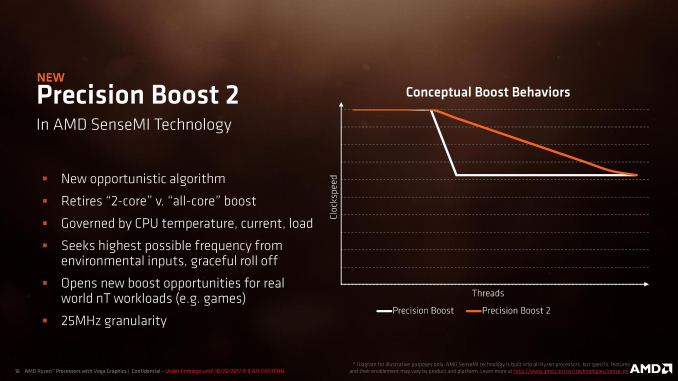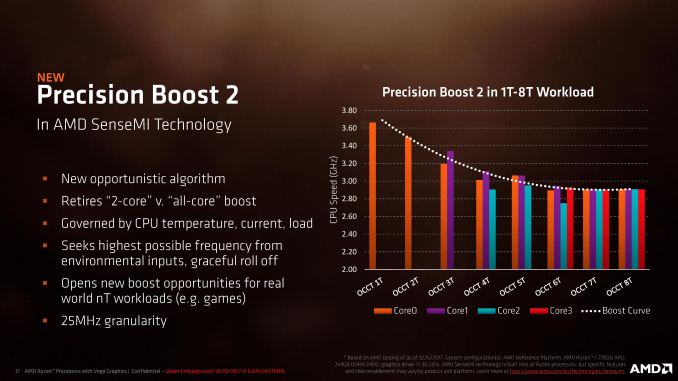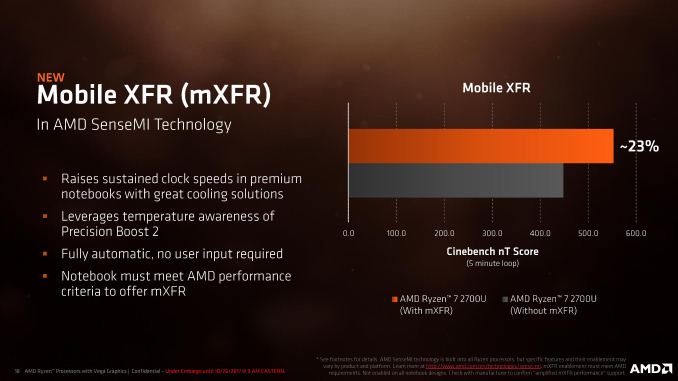Ryzen Mobile is Launched: AMD APUs for Laptops, with Vega and Updated Zen
by Ian Cutress on October 26, 2017 9:00 AM ESTSense Me Ryzen: Better Boost
When AMD launched the desktop Zen processors, it also branded a series of five technologies under the ‘SenseMI’ name. We covered these in detail in our Ryzen 7 review, but in short, it covers the following:
- Pure Power: Sensors to optimize power consumption
- Precision Boost: Determines how Turbo is applied
- Extreme Frequency Range: Going above maximum turbo when possible
- Neural Net Prediction: Using Neural Nets for prefetching data
- Smart Prefetch: Algorithms that work to enhance prefetch
With Ryzen Mobile, the features relating to frequency get an updated model, while Pure Power gets a bigger boost. We’ll cover the power changes on the next page, but it is worth talking about how AMD has improved Precision Boost and brought XFR to laptops.
Precision Boost 2
Most CPU turbo algorithms work by sensing how many cores and threads are under load, determining if the CPU has enough power headroom, and applying a voltage. This is why in the past both of the major x86 CPU manufacturers will quote a ‘per-core turbo frequency’ to show what the frequency should be when different numbers of cores are loaded and all else is fine (there is temperature/power headroom).
For Ryzen Mobile, AMD is pivoting to a new turbo model. When the system is in the P0 (top) turbo state, the system will use a new opportunistic turbo algorithm that rather than being based on the cores under load, is governed by CPU temperatures, currents, and how much load is being applied. The algorithm takes into account all the environmental inputs, such as skin temperature sensors and battery life, and will provide the best turbo frequency it can, regardless of if one thread is being used or all threads are being used.
It will be able to provide boost amounts at the 25 MHz granularity level, similar to how the desktop processors work, with the idea being that in most cases, if the system has a lot of cores available and a background process performs some very light work (such as checking for updates), rather than dropping 500-800 MHz because more cores are loaded, the system will keep at the high frequency.
AMD is stating that this has a big effect on real-world workloads, typically those that have variable thread workloads such as gaming.
When asked if Precision Boost 2 would be coming to the next generation of AMD’s Desktop Ryzen processors, I was told that ‘it could be inferred / it’s a safe bet’.
Mobile Extended Frequency Range (mXFR)
Because mobile systems are thermally limited, battery limited, power limited, and battery limited, offering ‘extra’ turbo headroom is not really something that processor manufacturers like to do. As a result, most of the Ryzen Mobile-powered notebooks will not have any form of XFR – AMD will be allowing it on a case-by-case basis for vendors that overengineer their chassis to be capable of supporting a higher power profile.
This feature essentially extends the average level at which Precision Boost 2 will operate, and also marks what could be considered a higher configurable TDP. One of the systems being launched with Ryzen Mobile this side of Christmas will be mXFR enabled, because the chassis is designed for 25W rather than 15W. It is worth noting that AMD states the configurable TDP of the Ryzen Mobile chips goes up to 25W, so this is likely the case what is happening.
Encode and Decode
AMD is fully using Vega’s encode and decode capabilities with Ryzen Mobile. The big inclusion for AMD’s mobile devices is the ability to decode VP9, the codec prefered in particular by YouTube.
| AMD Ryzen Mobile Encode/Decode Capabilities | |||||
| Decode 1080p @ 4:2:0 |
Decode 2160p @ 4:2:0 |
Encode 1080p |
Encode 1440p |
Encode 2160p |
|
| MPEG2 | 60 FPS | - | |||
| VC1 | 60 FPS | - | |||
| VP9 8/10 bpc | 240 FPS | 60 FPS | |||
| H.264 8 bpc | 240 FPS | 60 FPS | 120 FPS | 60 FPS | 30 FPS |
| H.264 10 bpc | 240 FPS | 60 FPS | |||
| HEVC 8bpc | 240 FPS | 60 FPS | 120 FPS | 60 FPS | 30 FPS |
| HEVC 10 bpc | 240 FPS | 60 FPS | |||
| JPEC 8bpc | 240 FPS | 60 FPS | |||













140 Comments
View All Comments
haukionkannel - Thursday, October 26, 2017 - link
Promising, promising indeed. But Ryzen did show that mobile parts can delivery this time too.But as other have said. We need these in cheap models, medium prised models and high end Computers too!
Also differen sized devices. A 10” hyprid tablet would give Intel Atom based models good ride!
And bigger versions may have at least a fighting chance against intel m-series.
bill.rookard - Thursday, October 26, 2017 - link
I'm quite pleased that they managed to come in at 15w. I was reading around prior and thought they were going to be a 35w design, color me shocked. Now we just need to get some in for some testing - how convenient - right when I'm possibly in the market for a new laptop.smilingcrow - Thursday, October 26, 2017 - link
The vast majority of laptops are 15W these days and not just the Ultrabooks so they had to hit the 15W mark to compete.Krysto - Thursday, October 26, 2017 - link
And yet Intel hasn't hit that mark for quad-core chips yet...But I agree, all laptop chips should come in at 15W. Perhaps beefy gaming laptops could still go to 30W or so.
lmcd - Thursday, October 26, 2017 - link
Intel's TDP numbers tend to run more accurately. I wouldn't get too excited.smilingcrow - Thursday, October 26, 2017 - link
Intel recently released a quad core 15W TDP laptop CPU:https://ark.intel.com/products/122589/Intel-Core-i...
Here's a review showing that the actual power usage under load is much higher than for the dual core Kaby Lake:
https://www.notebookcheck.net/Dell-XPS-13-i7-8550U...
Not sure if that system has using a TD-up of 25W or not!
SaturnusDK - Thursday, October 26, 2017 - link
It's not. 40-45W power use under load seems to be standard on all Intel 8th gen so called "15W TDP" mobile CPUs. Previously, or at least from 4th to 7th gen you could be pretty sure that power use under load was almost always just under twice the stated TDP. My own i7-6660U uses 29W under load measured at the voltage rails for example.Intel has lost all credibility when it comes to giving accurate power consumption data.
SaturnusDK - Thursday, October 26, 2017 - link
I have to mention. The 29W is with the CPU and GPU undervolted by 100mV.extide - Friday, October 27, 2017 - link
15W is the TDP, not the max power use. Due to turbo the chips will go past that by a fair amount in bursts, but the average over long periods will be ~15w. This applies to Intel AND AMD. (Either company would be stupid to not do that as you would be leaving tons of burst performance on the table and that is what a lot of real-world use is)wumpus - Thursday, October 26, 2017 - link
200/127/.50 Sounds less impressive when you look at the size of the chip vs. others (although the recent chips appear to be roughly half covered) and realize they are bulldozer-based.The size appears similar to the full Zepplin (8 core) die. Don't expect it to be cheap. Also it appears that Vega will have to make due with shared DDR4 dram, no idea how that will work (I've been dreaming of an HBM area the CPU can use as a cache when the GPU doesn't need it, don't expect such things anytime soon).